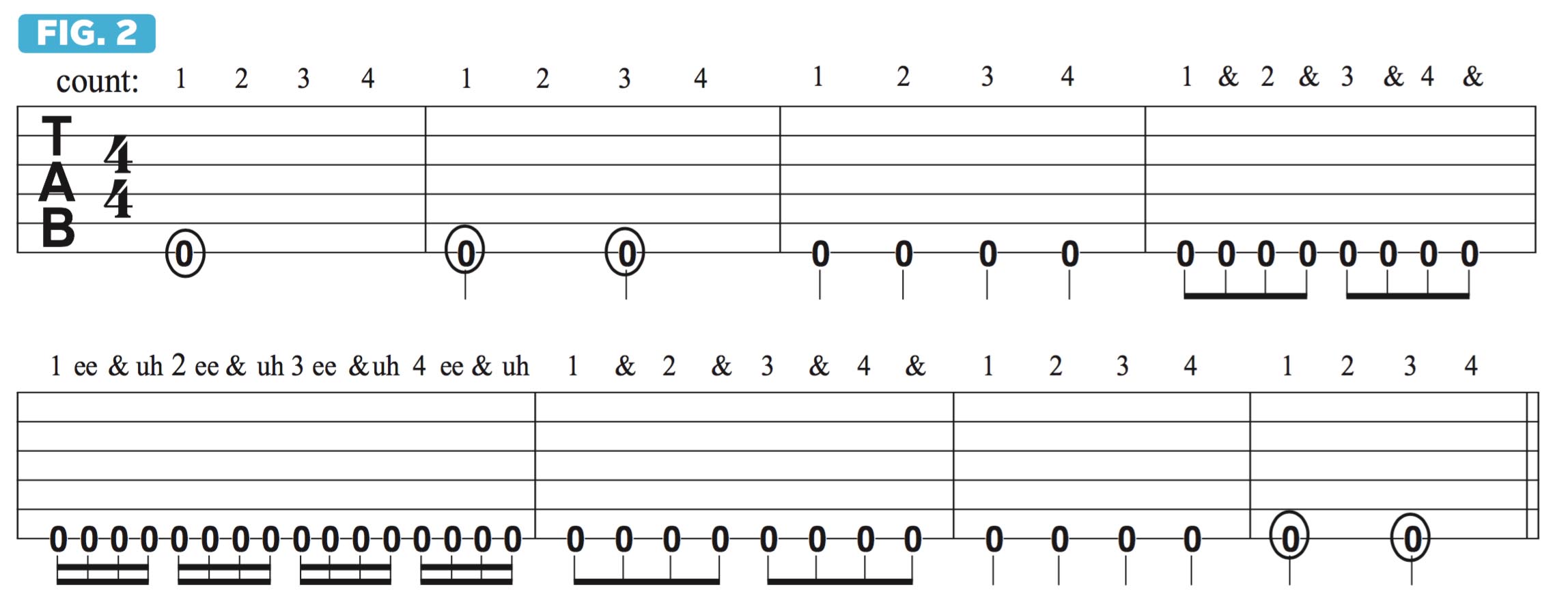Improve your rhythm playing with this guide to 16th notes, the roots of chug
Count in the next stage in your rhythm guitar evolution

In previous columns, we've looked at a bunch of different examples of ways in which musicians will typically accentuate the eighth-note upbeats – those “and” counts between the beats – to produce a variety of interesting and dramatic syncopations in 44 meter.
As we saw, this can add rhythmic flair to a groove or song and create an energetic feeling of forward motion. I’d now like to introduce you to a deeper level of rhythmic complexity, using what are called 16th notes, which involve dividing a bar of 44 into 16 units.
In the same way that you can split, or subdivide, a quarter note in half to produce two eighth notes, you can likewise split an eighth note in half to get two 16th notes, each of which has half the duration of an eighth note and therefore goes by twice as quickly.
If you do that to a pair of eighth notes across one beat, the result is a four-note set of 16th notes – “da-da-da-da” – which some musicians refer to as a “quad.”
In both standard sheet music and Guitar World’s rhythmic tab notation, those four 16th notes are grouped together with their vertical stems connected by two parallel, horizontal beams (see Figure 1). So one beam for eighth notes, two for 16th notes.
Now, if we were to do the same thing across all four beats in a bar of 44, we would get, as I mentioned earlier, 16 evenly spaced 16th notes, or four quads – one for each beat (4 x 4 = 16).
Sixteenth notes are counted “1 ee and uh, 2 ee and uh, 3 ee and uh, 4 ee and uh.” This builds upon the foundational eighth-note count, “1 and, 2 and, 3 and, 4 and,” only now we’re adding two extra syllables, “ee” and “uh,” which are inserted before and after “and,” to mark the second and fourth 16th notes of a given beat.
The first and third 16th notes still coincide with the eighth notes. By subdividing the beat into 16th notes, we’ve now more than doubled the rhythmic possibilities that were available using only eighth, quarter, half and whole notes, and we can now include 16th notes in many combinations with these larger and slower rhythmic values to create dozens of new phrasing schemes.

And that’s not even including the use of ties and 16th rests, which is something we will get round to exploring in the next lesson. Sixteenth notes are usually performed with alternate picking – down, up, down, up. etc.
However, in metal and hard rock, players like James Hetfield of Metallica and Megadeth’s Dave Mustaine have made great use of and popularized a technique called “chugging,” which refers to picking palm-muted consecutive downstrokes, typically, but not always, with a repeating single note, such as the open low E string, or with a root-5th power chord, using a high-gain “crunch tone,” which would be your guitar’s bridge humbucker pickup with distortion.
Chugging is a physically demanding technique, and it takes a great deal of practice to build up the speed and stamina required to play metal riffs with conviction
The result is a very intense, uniform note attack, which you can’t quite replicate using alternate picking, which sounds different and “swishy” because the upstrokes.
Chugging is a physically demanding technique, and it takes a great deal of practice to build up the speed and stamina required to play metal riffs with conviction and get through an entire song without your hand becoming fatigued or cramping up.
To help acquaint you with some of the phrasing possibilities available with 16th notes, here are a couple of examples of some basic ways that you can combine the rhythmic values we’ve learned thus far and count them out (see Figures 2 and 3).

For the sake of focusing strictly on the rhythm here, I’m deliberately using only one repeating note, the open low E string. You could, of course, substitute other notes, or chords, to make things sound more interesting. (See video for examples.)

As you sight-read and play these rhythms, do yourself a favor and make a habit of tapping your foot squarely on each beat, like a metronome, as you count the beats and subdivisions, either out loud or in your head.
Doing this is the key to being able to school yourself in rhythmic knowledge and wrap your head around this marvelous grid of metric combinations without losing track of the beats.
Get The Pick Newsletter
All the latest guitar news, interviews, lessons, reviews, deals and more, direct to your inbox!
Over the past 30 years, Jimmy Brown has built a reputation as one of the world's finest music educators, through his work as a transcriber and Senior Music Editor for Guitar World magazine and Lessons Editor for its sister publication, Guitar Player. In addition to these roles, Jimmy is also a busy working musician, performing regularly in the greater New York City area. Jimmy earned a Bachelor of Music degree in Jazz Studies and Performance and Music Management from William Paterson University in 1989. He is also an experienced private guitar teacher and an accomplished writer.










![Joe Bonamassa [left] wears a deep blue suit and polka-dotted shirt and plays his green refin Strat; the late Irish blues legend Rory Gallagher [right] screams and inflicts some punishment on his heavily worn number one Stratocaster.](https://cdn.mos.cms.futurecdn.net/cw28h7UBcTVfTLs7p7eiLe.jpg)
